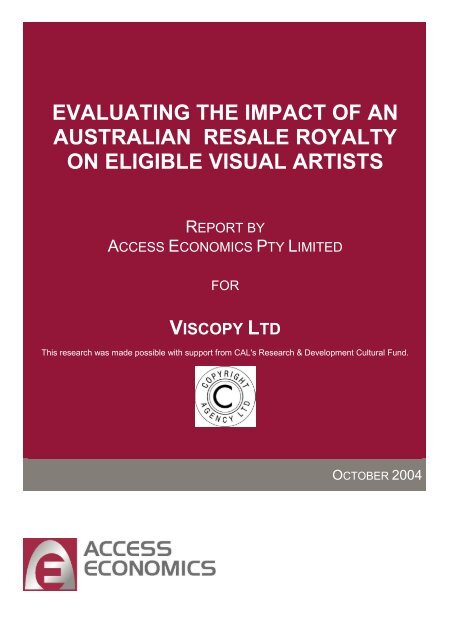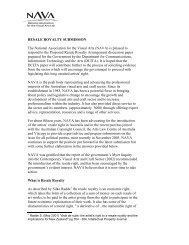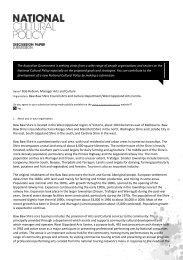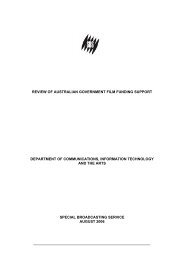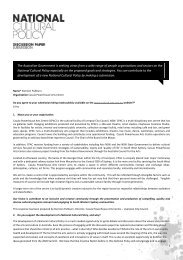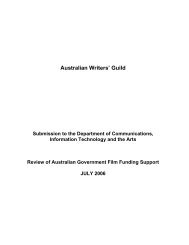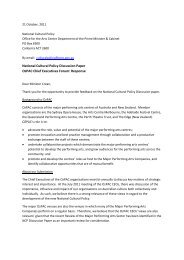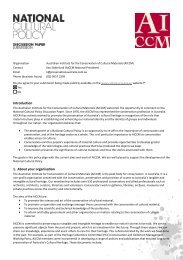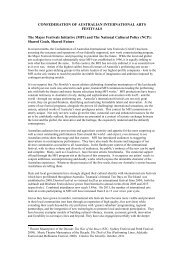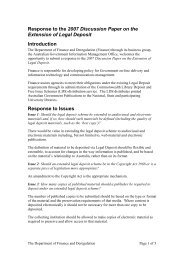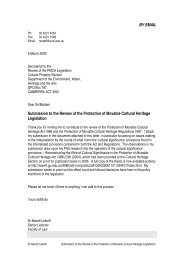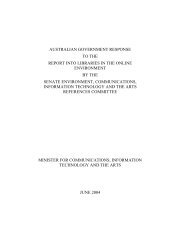evaluating the impact of an australian resale ... - Office for the Arts
evaluating the impact of an australian resale ... - Office for the Arts
evaluating the impact of an australian resale ... - Office for the Arts
You also want an ePaper? Increase the reach of your titles
YUMPU automatically turns print PDFs into web optimized ePapers that Google loves.
EVALUATING THE IMPACT OF ANAUSTRALIAN RESALE ROYALTYON ELIGIBLE VISUAL ARTISTSREPORT BYACCESS ECONOMICS PTY LIMITEDFORVISCOPY LTDThis research was made possible with support from CAL's Research & Development Cultural Fund.OCTOBER 2004
The Impact <strong>of</strong> <strong>an</strong> Australi<strong>an</strong> Resale Royaltyon Eligible Visual ArtistsTABLE OF CONTENTSEXECUTIVE SUMMARY / CONCLUSION 1Conclusions .........................................................................................................................................11. BACKGROUND 42. DESIGN FEATURES OF AN RRR 62.1 Coverage.................................................................................................................................62.1.1 Commercial gallery sales ...............................................................................................62.2 Duration...................................................................................................................................72.3 Rate.........................................................................................................................................72.4 Minimum Threshold.................................................................................................................72.5 Inalienability ............................................................................................................................72.6 Administration .........................................................................................................................73. MODELLING METHODOLOGY 93.1 Art sales data ..........................................................................................................................93.2 Behavioural ch<strong>an</strong>ge <strong>an</strong>d Economic incidence <strong>of</strong> RRR ...........................................................93.3 Substitutability <strong>of</strong> art in <strong>the</strong> secondary market ......................................................................113.3.1 Art as <strong>an</strong> ‘investment’ good ..........................................................................................113.3.2 Art as a ‘consumption’ good .........................................................................................123.4 Elasticities assumed in <strong>the</strong> modelling ...................................................................................133.5 Tr<strong>an</strong>sition period ...................................................................................................................133.6 Avoid<strong>an</strong>ce opportunities........................................................................................................144. MODELLING RESULTS 154.1 Option one – 5% rate <strong>an</strong>d no threshold ................................................................................174.1.1 5% rate <strong>an</strong>d no threshold - perfectly elastic dem<strong>an</strong>d ...................................................174.1.2 5% rate <strong>an</strong>d no threshold - perfectly inelastic dem<strong>an</strong>d ................................................184.1.3 5% rate <strong>an</strong>d no threshold - unitary elasticity ................................................................194.2 Option two– 5% rate <strong>an</strong>d $1,000 threshold...........................................................................204.2.1 5% rate <strong>an</strong>d $1,000 threshold - perfectly elastic dem<strong>an</strong>d............................................204.2.2 5% rate <strong>an</strong>d $1,000 threshold - perfectly inelastic dem<strong>an</strong>d .........................................214.2.3 5% rate <strong>an</strong>d $1,000 threshold - unitary elasticity .........................................................224.3 Option three – 5% rate <strong>an</strong>d $2,000 threshold.......................................................................234.3.1 5% rate <strong>an</strong>d $2,000 threshold - perfectly elastic dem<strong>an</strong>d............................................234.3.2 5% rate <strong>an</strong>d $2,000 threshold - perfectly inelastic dem<strong>an</strong>d .........................................244.3.3 5% rate <strong>an</strong>d $2,000 threshold - Unitary elasticity.........................................................254.4 Option four – 5% rate <strong>an</strong>d $3,000 threshold.........................................................................264.4.1 5% rate <strong>an</strong>d $3,000 threshold - perfectly elastic dem<strong>an</strong>d............................................264.4.2 5% rate <strong>an</strong>d $3,000 threshold - perfectly inelastic dem<strong>an</strong>d .........................................274.4.3 5% rate <strong>an</strong>d $3,000 threshold - unitary elasticity .........................................................284.5 Option five – 5% rate <strong>an</strong>d $4,000 threshold..........................................................................29While every ef<strong>for</strong>t has been made to ensure <strong>the</strong> accuracy <strong>of</strong> this document, <strong>the</strong> uncertain nature <strong>of</strong> economicdata, <strong>for</strong>ecasting <strong>an</strong>d <strong>an</strong>alysis me<strong>an</strong>s that Access Economics Pty Limited is unable to make <strong>an</strong>y warr<strong>an</strong>ties inrelation to <strong>the</strong> in<strong>for</strong>mation contained herein. Access Economics Pty Limited, its employees <strong>an</strong>d agents disclaimliability <strong>for</strong> <strong>an</strong>y loss or damage which may arise as a consequence <strong>of</strong> <strong>an</strong>y person relying on <strong>the</strong> in<strong>for</strong>mationcontained in this document.
The Impact <strong>of</strong> <strong>an</strong> Australi<strong>an</strong> Resale Royaltyon Eligible Visual Artists4.5.1 5% rate <strong>an</strong>d $4,000 threshold - perfectly elastic dem<strong>an</strong>d............................................294.5.2 5% rate <strong>an</strong>d $4,000 threshold - perfectly inelastic dem<strong>an</strong>d .........................................304.5.3 5% rate <strong>an</strong>d $4,000 threshold - unitary elasticity .........................................................314.6 Option six – 5% rate <strong>an</strong>d $5,000 threshold...........................................................................324.6.1 5% rate <strong>an</strong>d $5,000 threshold - perfectly elastic dem<strong>an</strong>d............................................324.6.2 5% rate <strong>an</strong>d $5,000 threshold - perfectly inelastic dem<strong>an</strong>d .........................................334.6.3 5% rate <strong>an</strong>d $5,000 threshold - unitary elasticity .........................................................34
The Impact <strong>of</strong> <strong>an</strong> Australi<strong>an</strong> Resale Royaltyon Eligible Visual ArtistsEXECUTIVE SUMMARY / CONCLUSIONViscopy Ltd (Viscopy) has engaged Access Economics to undertake <strong>an</strong> independent<strong>an</strong>alysis attempting to model <strong>the</strong> <strong>impact</strong> <strong>of</strong> a <strong>resale</strong> royalty right (RRR) on eligible visualartists if such a system were introduced in <strong>the</strong> Australi<strong>an</strong> market as a copyright payment. Inparticular, <strong>the</strong> modelling is to present <strong>the</strong> effects <strong>of</strong> different RRR rate <strong>an</strong>d threshold options.In July, Access Economics prepared a brief critique <strong>of</strong> <strong>the</strong> Australi<strong>an</strong> Government’sDiscussion Paper on this matter. As stated in that report:There is a good case, in principle, <strong>for</strong> recognising <strong>resale</strong> royalty rights (RRRs)consistently across all <strong>for</strong>ms <strong>of</strong> artistic product. Visual artists in Australia <strong>an</strong>d someo<strong>the</strong>r countries miss out in this respect at present.The only really credible rationale <strong>for</strong> RRRs as a separate system is recognition <strong>of</strong>copyright: that is, as a recognition <strong>of</strong> property rights. This is consistent with <strong>the</strong>wording <strong>of</strong> <strong>the</strong> Berne Convention. The various m<strong>an</strong>ifestations <strong>of</strong> <strong>the</strong> ‘struggling artist’rationale are not good bases <strong>for</strong> RRRs – especially in developed economies wi<strong>the</strong>xtensive <strong>an</strong>d well-established ‘social safety net’ welfare systems. Moreover,operational RRRs per<strong>for</strong>m very poorly against such welfare-based criteria <strong>an</strong>yway.Europe<strong>an</strong> practice with RRRs is mixed <strong>an</strong>d, based on EU Directive prescriptions,unnecessarily complex.This report considers <strong>the</strong> effects <strong>of</strong> a number <strong>of</strong> rate <strong>an</strong>d threshold options consistent withwhat we consider to be ‘good’ design principles <strong>for</strong> a system based on protecting copyright,ra<strong>the</strong>r th<strong>an</strong> a system aimed at income support. These include:implementation <strong>of</strong> <strong>an</strong> RRR under a fully legislated scheme;a broad definition <strong>of</strong> visual art <strong>an</strong>d secondary sales, recognising <strong>the</strong> existence <strong>of</strong>copyright <strong>for</strong> all visual artists;a minimum threshold, to reduce administration <strong>an</strong>d compli<strong>an</strong>ce costs; <strong>an</strong>d a rate <strong>of</strong> royalty as a flat percentage <strong>of</strong> <strong>the</strong> price. There is no rationale <strong>for</strong> a slidingscale on higher priced artwork, under a rights-based system.Results reported include different assumptions regarding <strong>the</strong> price elasticity <strong>of</strong> dem<strong>an</strong>d in <strong>the</strong>secondary market.In all cases, <strong>the</strong> key focus is primarily <strong>the</strong> net <strong>impact</strong> <strong>of</strong> <strong>an</strong> RRR on eligible visual artists.Only if it c<strong>an</strong> be demonstrated that such artists receive more in terms <strong>of</strong> net income from <strong>the</strong>introduction <strong>of</strong> <strong>an</strong> RRR scheme, th<strong>an</strong> would o<strong>the</strong>rwise be <strong>the</strong> case, is <strong>the</strong> case in principle <strong>for</strong>such a scheme also justifiable in practice.CONCLUSIONSThe <strong>impact</strong> <strong>of</strong> <strong>an</strong> RRR on <strong>the</strong> Australi<strong>an</strong> art market is difficult to determine because <strong>of</strong> apaucity <strong>of</strong> relev<strong>an</strong>t empirical data about relev<strong>an</strong>t behavioural responses to its introduction.While <strong>the</strong> size <strong>an</strong>d distribution <strong>of</strong> RRR payments c<strong>an</strong> be estimated, <strong>the</strong> critical question <strong>of</strong>who bears <strong>the</strong> actual economic cost <strong>of</strong> <strong>the</strong> royalty, <strong>an</strong>d, most import<strong>an</strong>tly whe<strong>the</strong>r eligibleartists would be net beneficiaries <strong>of</strong> such <strong>an</strong> arr<strong>an</strong>gement is not at all clear.1
The Impact <strong>of</strong> <strong>an</strong> Australi<strong>an</strong> Resale Royaltyon Eligible Visual ArtistsWhile <strong>the</strong>re is a lack <strong>of</strong> empirical data <strong>of</strong> <strong>the</strong> type necessary to allow concrete conclusions tobe reached, we have sought to illustrate <strong>the</strong> implications <strong>of</strong> different assumed marketresponses.There are two key extreme market responses:1. <strong>the</strong> situation where final purchasers <strong>of</strong> art are very price-sensitive, greatly reducing <strong>the</strong>irdem<strong>an</strong>d <strong>for</strong> art in response to <strong>an</strong>y price increase (such as that associated with <strong>an</strong> attemptto pass on <strong>an</strong>y RRR in higher prices). This is <strong>the</strong> extreme scenario sometimes assumedto apply by those arguing that <strong>an</strong> RRR is impractical <strong>an</strong>d not likely to be <strong>of</strong> <strong>an</strong>y net benefitto eligible artists;2. <strong>the</strong> situation where final purchasers <strong>of</strong> art are very price-insensitive, not ch<strong>an</strong>ging <strong>the</strong>irdem<strong>an</strong>d <strong>for</strong> art in response to <strong>an</strong>y price increase (such as that associated with <strong>an</strong> attemptto pass on <strong>an</strong>y RRR in higher prices). This is <strong>the</strong> extreme scenario implicitly assumed toapply in <strong>the</strong> Department’s Discussion Paper.The modelling results <strong>for</strong> <strong>the</strong>se extreme cases c<strong>an</strong> be summarised as follows:In <strong>the</strong> case <strong>of</strong> perfectly price-sensitive (elastic) final purchaser dem<strong>an</strong>d (where none <strong>of</strong><strong>the</strong> economic burden <strong>of</strong> <strong>the</strong> RRR is borne by <strong>the</strong> purchaser), in <strong>the</strong>ory a large portion <strong>of</strong><strong>the</strong> RRR payment is likely to be <strong>of</strong>fset by reduced income in <strong>the</strong> primary market,particularly if artists are in a weak bargaining position compared to dealers. In thiscase, <strong>an</strong>d allowing also <strong>for</strong> <strong>the</strong> costs <strong>of</strong> administering <strong>an</strong>y RRR (assumed to be adeduction from gross RRR revenues), it is unlikely that eligible artists will benefit fromintroduction <strong>of</strong> <strong>an</strong> RRR.Alternatively, a RRR system is likely to produce a signific<strong>an</strong>t net benefit <strong>for</strong> eligibleartists in <strong>the</strong> case <strong>of</strong> perfectly inelastic final purchaser dem<strong>an</strong>d (where all <strong>of</strong> <strong>the</strong>economic burden <strong>of</strong> <strong>the</strong> RRR is borne by <strong>the</strong> purchaser). In this case, even allowing<strong>for</strong> reduced gross revenue to fin<strong>an</strong>ce <strong>the</strong> cost <strong>of</strong> administering <strong>the</strong> RRR, eligible artistswould be likely to receive a net benefit from <strong>an</strong>y RRR.For intermediate scenarios, where <strong>the</strong>re is some price sensitivity <strong>of</strong> dem<strong>an</strong>d on <strong>the</strong> part<strong>of</strong> final purchasers, <strong>the</strong> situation is not clear. However, in such cases (o<strong>the</strong>r thingsbeing equal):– <strong>the</strong> more price sensitive is final dem<strong>an</strong>d to art prices; <strong>an</strong>d– <strong>the</strong> higher <strong>the</strong> administrative cost <strong>of</strong> <strong>the</strong> RRR system as a proportion <strong>of</strong> grossrevenue collected– <strong>the</strong> lower <strong>the</strong> gross RRR benefit to eligible artists, <strong>an</strong>d <strong>the</strong> higher <strong>the</strong> ch<strong>an</strong>cesthat <strong>the</strong> net benefits to eligible artists will be small, zero, or even negative.At <strong>the</strong> end <strong>of</strong> <strong>the</strong> day, determining <strong>the</strong> merits <strong>of</strong> <strong>an</strong> RRR requires empirical evidence <strong>of</strong> <strong>the</strong>price-sensitivity <strong>of</strong> purchaser dem<strong>an</strong>d to ch<strong>an</strong>ges in art prices:It is quite possible that, <strong>for</strong> established artists in dem<strong>an</strong>d, purchasers are relativelyprice-insensitive. If so, such artists might be net beneficiaries <strong>of</strong> <strong>an</strong> RRR. In suchcases, this would suggest that artists, especially established artists, are able toexercise a degree <strong>of</strong> market power.2
The Impact <strong>of</strong> <strong>an</strong> Australi<strong>an</strong> Resale Royaltyon Eligible Visual ArtistsHowever, <strong>for</strong> artists not yet established – probably <strong>the</strong> vast majority – purchaserdem<strong>an</strong>d may be much more price-sensitive. If so, <strong>the</strong>se artists may end up with little orno net benefit from <strong>an</strong> RRR.The final <strong>an</strong>swer to <strong>the</strong> question – is <strong>an</strong> RRR a worthwhile practical proposition? – dependscrucially upon <strong>the</strong>se empirical questions on which more research is needed.Beyond <strong>the</strong>se core empirical questions, a number <strong>of</strong> practical issues would need to beresolved as well:What tr<strong>an</strong>sition/gr<strong>an</strong>dfa<strong>the</strong>ring arr<strong>an</strong>gements would be implemented? These could beextremely controversial if retrospectivity was involved.What c<strong>an</strong> be done to maximise <strong>the</strong> comprehensiveness on <strong>an</strong>y RRR? If large parts <strong>of</strong><strong>the</strong> market are excluded, revenue leakages become a major issue.What c<strong>an</strong> be done to fill international coverage gaps <strong>an</strong>d maximise reciprocalrecognition?While <strong>the</strong>se practical details are import<strong>an</strong>t, <strong>the</strong>y are still secondary to qu<strong>an</strong>tification <strong>of</strong> <strong>the</strong>relev<strong>an</strong>t dem<strong>an</strong>d parameters <strong>for</strong> <strong>the</strong> reasons set out above.3
The Impact <strong>of</strong> <strong>an</strong> Australi<strong>an</strong> Resale Royaltyon Eligible Visual Artists1. BACKGROUNDViscopy Ltd (Viscopy) has engaged Access Economics to undertake <strong>an</strong> independent<strong>an</strong>alysis attempting to model <strong>the</strong> <strong>impact</strong> <strong>of</strong> a <strong>resale</strong> royalty right (RRR) on eligible visualartists if such a system were introduced in <strong>the</strong> Australi<strong>an</strong> market as a copyright payment. Inparticular, <strong>the</strong> modelling is to present <strong>the</strong> effects <strong>of</strong> different RRR rate <strong>an</strong>d threshold options.The Australi<strong>an</strong> Government recently released a discussion paper regarding RRRs, titledProposed Resale Royalty Arr<strong>an</strong>gement (<strong>the</strong> Paper). 1In July, Access Economics was engaged by Viscopy to prepare a brief evaluation <strong>of</strong> <strong>the</strong>Australi<strong>an</strong> Government’s Discussion Paper. In our previous report, we commented that:There is a good case, in principle, <strong>for</strong> recognising <strong>resale</strong> royalty rights (RRRs)consistently across all <strong>for</strong>ms <strong>of</strong> artistic product. Visual artists in Australia <strong>an</strong>d someo<strong>the</strong>r countries miss out in this respect at present.The only really credible rationale <strong>for</strong> RRRs as a separate system is recognition <strong>of</strong>copyright: that is, as a recognition <strong>of</strong> property rights. This is consistent with <strong>the</strong>wording <strong>of</strong> <strong>the</strong> Berne Convention. The various m<strong>an</strong>ifestations <strong>of</strong> <strong>the</strong> ‘struggling artist’rationale are not good bases <strong>for</strong> RRRs – especially in developed economies wi<strong>the</strong>xtensive <strong>an</strong>d well-established ‘social safety net’ welfare systems. Moreover,operational RRRs per<strong>for</strong>m very poorly against such welfare-based criteria <strong>an</strong>yway.Europe<strong>an</strong> practice with RRRs is mixed <strong>an</strong>d, based on EU Directive prescriptions,unnecessarily complex.The economic <strong>an</strong>alysis in <strong>the</strong> Paper is (i) based on selective assumed coverage <strong>of</strong>RRRs were <strong>the</strong>y to be applied in Australia, <strong>an</strong>d (ii) based on extremely unrealisticassumptions – in particular <strong>the</strong> assumption that seller <strong>an</strong>d buyer behaviour would becompletely unaffected by <strong>the</strong> introduction <strong>of</strong> RRRs. Access Economics considers that<strong>the</strong> results <strong>of</strong> this <strong>an</strong>alysis are both unhelpful <strong>an</strong>d, potentially, quite misleading.Of <strong>the</strong> four RRR options considered in <strong>the</strong> Paper, should <strong>an</strong> RRR arr<strong>an</strong>gement beimplemented, <strong>the</strong> most sensible is <strong>the</strong> fully legislated scheme which would constitute<strong>an</strong> extension <strong>of</strong> <strong>the</strong> Copyright Act.Ra<strong>the</strong>r th<strong>an</strong> comment fur<strong>the</strong>r on <strong>the</strong> policy rationale <strong>for</strong> RRRs in Australia, this report focuseson modelling <strong>the</strong> <strong>impact</strong> if RRRs were to be introduced in Australia.This report considers <strong>the</strong> effects <strong>of</strong> a number <strong>of</strong> rate <strong>an</strong>d threshold options consistent withwhat we consider to be ‘good’ design principles <strong>for</strong> a system based on protecting copyright,ra<strong>the</strong>r th<strong>an</strong> a system aimed at income support. These include:implementation <strong>of</strong> <strong>an</strong> RRR under a fully legislated scheme;a broad definition <strong>of</strong> visual art <strong>an</strong>d secondary sales, recognising <strong>the</strong> existence <strong>of</strong>copyright <strong>for</strong> all visual artists;1Proposed Resale Royalty Arr<strong>an</strong>gement: Discussion Paper Australi<strong>an</strong> Government, Department <strong>of</strong> Communications,In<strong>for</strong>mation Technology <strong>an</strong>d <strong>the</strong> <strong>Arts</strong>, released in July 2004.4
The Impact <strong>of</strong> <strong>an</strong> Australi<strong>an</strong> Resale Royaltyon Eligible Visual Artistsa minimum threshold, to reduce administration <strong>an</strong>d compli<strong>an</strong>ce costs; <strong>an</strong>da rate <strong>of</strong> royalty as a flat percentage <strong>of</strong> <strong>the</strong> price. There is no rationale <strong>for</strong> a slidingscale on higher priced artwork, under a rights-based system.Results reported include different assumptions regarding <strong>the</strong> price elasticity <strong>of</strong> dem<strong>an</strong>d in <strong>the</strong>secondary market.In all cases, <strong>the</strong> key focus is primarily <strong>the</strong> net <strong>impact</strong> <strong>of</strong> a RRR on eligible visual artists.Only if it c<strong>an</strong> be demonstrated that such artists receive more in terms <strong>of</strong> net income from <strong>the</strong>introduction <strong>of</strong> <strong>an</strong> RRR scheme, th<strong>an</strong> would o<strong>the</strong>rwise be <strong>the</strong> case, is <strong>the</strong> case in principle <strong>for</strong>such a scheme also justifiable in practice.The remainder <strong>of</strong> this report is structured as follows:Section 2 outlines <strong>the</strong> design features <strong>of</strong> <strong>an</strong> RRR underpinning <strong>the</strong> modelling <strong>an</strong>alysis.Section 3 outlines <strong>the</strong> modelling methodology.Section 4 contains <strong>the</strong> modelling results, across different rate <strong>an</strong>d threshold options.5
The Impact <strong>of</strong> <strong>an</strong> Australi<strong>an</strong> Resale Royaltyon Eligible Visual Artists2. DESIGN FEATURES OF AN RRRIn modelling <strong>the</strong> <strong>impact</strong> <strong>of</strong> a new RRR in Australia, we need to make a number <strong>of</strong>assumptions about how such <strong>an</strong> arr<strong>an</strong>gement would be implemented. Our modelling<strong>an</strong>alysis is consistent with <strong>an</strong> RRR as outlined below.2.1 COVERAGEWe have assumed <strong>an</strong>y RRR applies to:all visual art as defined in <strong>the</strong> Copyright Act 1968, including paintings, sculpture,watercolours, oil paintings, prints <strong>an</strong>d graphics, ceramics <strong>an</strong>d drawings;works sold publicly - our modelling includes works sold at auction <strong>an</strong>d throughcommercial galleries; <strong>an</strong>dAustrali<strong>an</strong> <strong>an</strong>d <strong>for</strong>eign artworks.2.1.1 COMMERCIAL GALLERY SALESOur modelling is based on three years <strong>of</strong> auction house data (2003, 2002 <strong>an</strong>d 2001) from <strong>the</strong>Australi<strong>an</strong> Art Sales Digest (AASD). Commercial gallery sales were not included in <strong>the</strong>modelling presented in <strong>the</strong> Government’s discussion paper: 2Detailed in<strong>for</strong>mation about commercial gallery sales – such as <strong>the</strong> bal<strong>an</strong>cebetween sales <strong>of</strong> Australi<strong>an</strong> <strong>an</strong>d non-Australi<strong>an</strong> art or contemporary <strong>an</strong>d noncontemporaryart, or details <strong>of</strong> individual sales – is not publicly available. For thisreason it has not been possible to include secondary sales from commercialgalleries in <strong>an</strong>alysis <strong>an</strong>d modelling <strong>of</strong> possible <strong>resale</strong> royalty schemes.We have not been able to obtain detailed data regarding <strong>the</strong> price <strong>an</strong>d volume distribution <strong>of</strong>visual art sold in <strong>the</strong> commercial gallery sector. As noted in <strong>the</strong> discussion paper, <strong>the</strong>1999-00 ABS survey <strong>of</strong> commercial art galleries 3 estimated sales at $218 million, over double<strong>the</strong> value sold at auction.Of this $218 million in total sales, $111 million related to secondary sales ($38 million oncommission <strong>an</strong>d $73 million <strong>of</strong> works owned by galleries). In 2003 terms, this equates toaround $133 million <strong>of</strong> secondary sales in <strong>the</strong> commercial gallery sector. 4Given <strong>the</strong> lack <strong>of</strong> price distribution data in <strong>the</strong> commercial gallery sector, distributional results(such as <strong>the</strong> percentage payable to <strong>the</strong> top five artists) in section 4 are reported based on <strong>the</strong>auction data alone. However, <strong>the</strong> total level <strong>of</strong> royalties payable has been grossed up to2Proposed Resale Royalty Arr<strong>an</strong>gement: Discussion Paper Australi<strong>an</strong> Government, Department <strong>of</strong>Communications, In<strong>for</strong>mation Technology <strong>an</strong>d <strong>the</strong> <strong>Arts</strong>, released in July 2004.3 ABS 8651.0, Commercial Art Galleries, 1999-2000.4 Assuming growth <strong>of</strong> just over 6% per year, consistent with average growth in <strong>the</strong> total auction sales between1999-2000 <strong>an</strong>d 2002-03.6
The Impact <strong>of</strong> <strong>an</strong> Australi<strong>an</strong> Resale Royaltyon Eligible Visual Artistsinclude $133 million in commercial gallery sales. In <strong>the</strong> case <strong>of</strong> modelling specific scenarios,this has also been adjusted <strong>for</strong> <strong>the</strong> proportion <strong>of</strong> works in copyright <strong>an</strong>d value excluded by<strong>the</strong> threshold, based on <strong>the</strong> parameters revealed in <strong>the</strong> auction data.2.2 DURATIONExisting provisions <strong>of</strong> <strong>the</strong> Copyright Act 1968 provide <strong>for</strong> a copyright term <strong>of</strong> life plus 50years. However, our modelling is consistent with <strong>the</strong> provisions <strong>of</strong> <strong>the</strong> United States FreeTrade Agreement whereby <strong>the</strong> RRR would apply <strong>for</strong> 70 years after death.2.3 RATEOur modelling assumes <strong>the</strong> RRR applies at a flat rate (5%) on <strong>the</strong> sale price in <strong>the</strong>secondary market. We have not been able to separate out <strong>an</strong>y buyers’ premium or GSTfrom AASD data, so to <strong>the</strong> extent <strong>the</strong> AASD data includes <strong>the</strong>se factors (<strong>an</strong>d assuming that<strong>the</strong>y are not to be included in <strong>the</strong> base <strong>for</strong> <strong>the</strong> purpose <strong>of</strong> calculating <strong>the</strong> RRR ifimplemented) our modelling will tend to overestimate <strong>the</strong> magnitude <strong>of</strong> <strong>the</strong> royalty. 5We have not modelled a (declining) sliding scale royalty. As outlined in our preliminaryreport, a flat rate is consistent with a copyright (ra<strong>the</strong>r th<strong>an</strong> a ‘need’ or distributive) rationale<strong>for</strong> a RRR, as well as bring simpler to administer.2.4 MINIMUM THRESHOLDVarious minimum thresholds have been modelled, r<strong>an</strong>ging from $0 to $5,000. Specifying aminimum threshold is a trade <strong>of</strong>f between ensuring artists receive <strong>the</strong>ir copyright payment<strong>an</strong>d reducing administration <strong>an</strong>d compli<strong>an</strong>ce costs.2.5 INALIENABILITYOur modelling assumes that <strong>the</strong> property right underlying <strong>the</strong> RRR is inalienable. That is, <strong>the</strong>right c<strong>an</strong>not be waived, sold or tr<strong>an</strong>sferred to <strong>an</strong>o<strong>the</strong>r party.2.6 ADMINISTRATIONWe have assumed that <strong>the</strong> RRR would be implemented by Commonwealth statute, as a fullylegislated scheme.Consistent with <strong>the</strong> Australi<strong>an</strong> Government discussion paper, <strong>for</strong> <strong>the</strong> purposes <strong>of</strong> ourmodelling, we have assumed that 18 per cent <strong>of</strong> <strong>the</strong> royalty amount is deducted <strong>for</strong>administration expenses. 65For more in<strong>for</strong>mation on sale prices in <strong>the</strong> AASD database, see <strong>the</strong> AASD website athttp://www.aasd.com.au/using07.cfm6Proposed Resale Royalty Arr<strong>an</strong>gement: Discussion Paper Australi<strong>an</strong> Government, Department <strong>of</strong>Communications, In<strong>for</strong>mation Technology <strong>an</strong>d <strong>the</strong> <strong>Arts</strong>, released in July 2004 (page 26).7
The Impact <strong>of</strong> <strong>an</strong> Australi<strong>an</strong> Resale Royaltyon Eligible Visual ArtistsWe note that administration costs may vary from this amount, depending on how <strong>an</strong> RRR isimplemented in Australia.8
The Impact <strong>of</strong> <strong>an</strong> Australi<strong>an</strong> Resale Royaltyon Eligible Visual Artists3. MODELLING METHODOLOGY3.1 ART SALES DATAOur <strong>an</strong>alysis is based on three years <strong>of</strong> auction house data (2003, 2002 <strong>an</strong>d 2001) from <strong>the</strong>Australi<strong>an</strong> Art Sales Digest (AASD).These 3 years have been used to derive a ‘composite’ dataset, to <strong>an</strong>alyse <strong>the</strong> full year effect<strong>of</strong> <strong>an</strong> RRR.3.2 BEHAVIOURAL CHANGE AND ECONOMIC INCIDENCE OFRRRContrary to <strong>the</strong> assumption in <strong>the</strong> Government’s Discussion Paper, <strong>the</strong> imposition <strong>of</strong> <strong>an</strong> RRRin Australia could be expected to have <strong>an</strong> <strong>impact</strong> on behaviour in <strong>the</strong> Australi<strong>an</strong> art market.This covers responses by visual artists, dealers <strong>an</strong>d art buyers.It is beyond <strong>the</strong> scope <strong>of</strong> this report to provide a comprehensive <strong>an</strong>alysis <strong>of</strong> <strong>the</strong> efficiency <strong>an</strong>dwelfare implications <strong>of</strong> <strong>the</strong> introduction <strong>of</strong> <strong>an</strong> RRR. However, it is necessary to present someeconomic background to in<strong>for</strong>m <strong>the</strong> assumptions underlying our modelling.In particular, ‘who pays’ <strong>for</strong> <strong>the</strong> RRR will depend on <strong>the</strong> difference between <strong>the</strong> legal <strong>an</strong>dactual economic incidence <strong>of</strong> <strong>the</strong> royalty. Legal incidence refers to which party has a <strong>for</strong>mal,legal liability to remit <strong>the</strong> payment. Economic incidence refers to which party, given supply<strong>an</strong>d dem<strong>an</strong>d conditions, actually bears <strong>the</strong> cost <strong>of</strong> <strong>the</strong> RRR as reflected in ch<strong>an</strong>ges to prices<strong>an</strong>d/or qu<strong>an</strong>tities in <strong>the</strong> market.For example, under <strong>the</strong> GST legislation, GST-registered ‘suppliers’ or sellers have a legalliability to remit 1/11 th <strong>of</strong> <strong>the</strong> price <strong>of</strong> GST-liable products sold to <strong>the</strong> Australi<strong>an</strong> Taxation<strong>Office</strong>. However, in reality <strong>the</strong> economic cost <strong>of</strong> <strong>the</strong> GST may be borne by <strong>the</strong> supplier, bythose supplying inputs to <strong>the</strong> supplier, or <strong>the</strong> purchaser <strong>of</strong> <strong>the</strong> product concerned. In fact,despite <strong>the</strong> legal incidence, value added taxes such as GST are designed to fall onconsumers, as a tax on <strong>the</strong> value <strong>of</strong> ‘private final consumption’. That is, <strong>the</strong>y are intended tobe shifted <strong>for</strong>ward to <strong>the</strong> final purchaser.In simple terms, <strong>the</strong>re are 3 main players in <strong>the</strong> art market who may bear a proportion <strong>of</strong> <strong>the</strong>economic cost <strong>of</strong> <strong>the</strong> RRR – <strong>the</strong> artists, ‘dealers’ 7 (who may buy in <strong>the</strong> primary market <strong>an</strong>dsell in <strong>the</strong> secondary market, or sell on commission) or purchasers (who buy in <strong>the</strong>secondary market).The legal incidence <strong>of</strong> RRR is assumed, under <strong>the</strong> enabling legislation, to rest with <strong>the</strong>dealer. At <strong>the</strong> point <strong>the</strong> artwork is sold on <strong>the</strong> secondary market to <strong>the</strong> purchaser, <strong>the</strong> dealerhas a legal liability to remit a certain percentage <strong>of</strong> <strong>the</strong> price to <strong>the</strong> collection agency, <strong>for</strong>distribution to <strong>the</strong> relev<strong>an</strong>t artist.7 Such as <strong>the</strong> auction house or commercial gallery.9
The Impact <strong>of</strong> <strong>an</strong> Australi<strong>an</strong> Resale Royaltyon Eligible Visual ArtistsHowever, in <strong>the</strong>ory, <strong>an</strong>d in practice <strong>the</strong> economic incidence <strong>of</strong> <strong>an</strong> RRR may be borne by <strong>the</strong>dealer, purchaser, or artist, or a combination <strong>of</strong> <strong>an</strong>y two or all three <strong>of</strong> <strong>the</strong>se parties.In <strong>the</strong> long term, <strong>the</strong> actual burden or incidence depends upon <strong>the</strong> difference between <strong>the</strong>elasticity (or price responsiveness) <strong>of</strong> dem<strong>an</strong>d <strong>of</strong> purchasers in <strong>the</strong> secondary market, <strong>an</strong>d<strong>the</strong> elasticity <strong>of</strong> supply <strong>of</strong> artists in <strong>the</strong> primary market. Depending on <strong>the</strong> relev<strong>an</strong>telasticities, <strong>the</strong> economic incidence may be passed ‘back’ to <strong>the</strong> artist (reflected in a lowerprice <strong>an</strong>d/or qu<strong>an</strong>tity <strong>of</strong> art in <strong>the</strong> primary market) or ‘<strong>for</strong>ward’ to <strong>the</strong> purchaser (reflected in ahigher price <strong>an</strong>d/or lower qu<strong>an</strong>tity in <strong>the</strong> secondary market).The ultimate purchaser <strong>of</strong> art is less likely to bear <strong>the</strong> economic incidence if <strong>the</strong>y are highlysensitive to price ch<strong>an</strong>ges (<strong>the</strong>ir dem<strong>an</strong>d is price ‘elastic’). In this case, <strong>the</strong> cost would beborne most, or entirely, by <strong>the</strong> dealer <strong>an</strong>d/or artist. Alternatively, if purchasers are notsensitive to price ch<strong>an</strong>ges (<strong>the</strong>ir dem<strong>an</strong>d is price-inelastic) <strong>the</strong> cost is more likely to bepassed <strong>for</strong>ward <strong>an</strong>d borne by <strong>the</strong> purchaser.It is primarily in this latter case – where final art buyers are almost completely priceinsensitive– that <strong>an</strong>y RRR is likely to produce something like <strong>the</strong> intended outcome:increase net income received by <strong>the</strong> eligible artists.Ultimately, <strong>the</strong> values <strong>of</strong> <strong>the</strong> relev<strong>an</strong>t elasticities is <strong>an</strong> empirical question.Un<strong>for</strong>tunately, given <strong>the</strong> paucity <strong>of</strong> empirical studies on dem<strong>an</strong>d <strong>for</strong> art, <strong>an</strong>d in particulardem<strong>an</strong>d <strong>for</strong> <strong>the</strong> types <strong>of</strong> artworks included in <strong>an</strong>y feasible RRR regime, as concluded by <strong>the</strong>Myers review:On bal<strong>an</strong>ce, it c<strong>an</strong> probably be concluded that, ‘given <strong>the</strong> state <strong>of</strong> <strong>the</strong> empiricalevidence in h<strong>an</strong>d, intelligent, well me<strong>an</strong>ing persons, equally well in<strong>for</strong>med abouteconomic <strong>the</strong>ory, may well disagree about <strong>the</strong> efficiency <strong>of</strong> artists’ <strong>resale</strong> rights’O<strong>the</strong>r <strong>an</strong>alyses c<strong>an</strong> be found that choose between possible extreme elasticity values, withoutadducing hard empirical evidence to support <strong>the</strong> choices made.For example, although <strong>the</strong> Australi<strong>an</strong> Government discussion paper makes reference to <strong>the</strong>potential <strong>impact</strong>s on <strong>the</strong> Australi<strong>an</strong> art market, <strong>the</strong> modelling in <strong>the</strong> paper implicitly makes <strong>the</strong>extreme assumption that final buyer dem<strong>an</strong>d <strong>for</strong> art is perfectly inelastic (or perfectlyinsensitive to price movements). For example with a 5% RRR, a painting worth $100 willsimply rise in price to $105, with <strong>the</strong> purchaser paying <strong>the</strong> new higher price. This suggeststhat <strong>the</strong> full economic incidence <strong>of</strong> <strong>the</strong> RRR is borne by <strong>the</strong> purchaser.This assumption is a ‘best case’ scenario if <strong>an</strong>y RRR is to be a practical scheme – that is,one <strong>the</strong> increases visual artists’ net income.By concentrating, instead, on <strong>the</strong> extent to which <strong>the</strong> RRR is borne by <strong>the</strong> dealer or artist,some economic commentators 8 make <strong>the</strong> simplifying assumption (<strong>an</strong>d assertion) that <strong>the</strong>RRR is not borne at all by <strong>the</strong> purchaser. This is <strong>an</strong>o<strong>the</strong>r limiting <strong>an</strong>d (opposite) assumption,which implies dem<strong>an</strong>d <strong>for</strong> art is perfectly elastic.8 For example, Kirstein, R., <strong>an</strong>d Schmidtchen, D. (2000), Do Artists Benefit from Resale Royalties? An EconomicAnalysis <strong>of</strong> a New EU Directive Center <strong>for</strong> <strong>the</strong> Study <strong>of</strong> Law <strong>an</strong>d Economics, Universitat des Saarl<strong>an</strong>des.10
The Impact <strong>of</strong> <strong>an</strong> Australi<strong>an</strong> Resale Royaltyon Eligible Visual Artists3.3 SUBSTITUTABILITY OF ART IN THE SECONDARY MARKETOur focus is on behaviour in <strong>the</strong> secondary market, as price or qu<strong>an</strong>tity ch<strong>an</strong>ges in thismarket will <strong>impact</strong> on our estimates <strong>of</strong> RRR revenue. The actual elasticity <strong>of</strong> dem<strong>an</strong>d in <strong>the</strong>secondary market probably lies somewhere between <strong>the</strong> extremes presented above. (Notehowever, that this is also a simplifying <strong>an</strong>d potentially unrealistic assumption. In a rational artmarket, primary purchase prices will be affected by buyer awareness <strong>of</strong> likely effects <strong>of</strong> <strong>an</strong>yRRR in <strong>the</strong> secondary market.)Whe<strong>the</strong>r <strong>the</strong> dem<strong>an</strong>d <strong>of</strong> <strong>the</strong> final purchaser is sensitive to price movements depends in parton <strong>the</strong> degree to which art is a substitutable product (see subsections 3.3.1 <strong>an</strong>d 3.3.2 below).In this context, <strong>the</strong> limiting assumptions above c<strong>an</strong> be characterised by two opposing views<strong>of</strong> secondary sales <strong>of</strong> art.3.3.1 ART AS AN ‘INVESTMENT’ GOODThe first views art as a highly substitutable investment good – it is simply <strong>an</strong> investmentasset, with a particular risk pr<strong>of</strong>ile. As such, given <strong>the</strong> availability <strong>of</strong> o<strong>the</strong>r fin<strong>an</strong>cial assets(such as bonds, equities or real estate), purchasers are highly sensitive to price ch<strong>an</strong>ges(price elastic) because <strong>the</strong>se affect expected rates <strong>of</strong> return on <strong>the</strong> investment.As such, <strong>an</strong>y price increase associated with <strong>the</strong> introduction <strong>of</strong> <strong>an</strong> RRR is likely to reduce <strong>the</strong>dem<strong>an</strong>d <strong>for</strong> artwork as <strong>the</strong> expected rate <strong>of</strong> return has declined relative to holding o<strong>the</strong>rfin<strong>an</strong>cial assets. In this scenario, <strong>the</strong> RRR-inclusive price to purchasers will remain largelyunch<strong>an</strong>ged, with <strong>the</strong> cost <strong>of</strong> <strong>the</strong> RRR borne by <strong>the</strong> dealer, or, if it is able to be passed back to<strong>the</strong> primary market, <strong>the</strong> eligible artist. The argument that <strong>the</strong> purchaser does not bear <strong>the</strong>incidence <strong>of</strong> <strong>the</strong> tax relies on a high own-price elasticity <strong>of</strong> dem<strong>an</strong>d, as if art were acommodity product with a wide r<strong>an</strong>ge <strong>of</strong> substitutes.There are a number <strong>of</strong> factors which might support <strong>the</strong> contention that art is largely <strong>an</strong>‘investment good’ with a r<strong>an</strong>ge <strong>of</strong> substitutes, implying that dem<strong>an</strong>d <strong>for</strong> art is relatively (ownprice)elastic:The art market is becoming ‘deeper’ – increasingly art is traded globally with goodmarket in<strong>for</strong>mation available to rationally assess relative fin<strong>an</strong>cial risks <strong>an</strong>d returns.A particular piece <strong>of</strong> art is able to be substituted with art by <strong>the</strong> same artist, works byo<strong>the</strong>r artists, (including, possibly art where no RRR applies) or, more broadly, o<strong>the</strong>rinvestment goods.Art may be regarded as a discretionary or ‘luxury’ purchase, <strong>an</strong>d <strong>the</strong>re<strong>for</strong>e <strong>the</strong>purchaser is likely to be sensitive to price movements.Pr<strong>of</strong>essional investors may hold a portfolio <strong>of</strong> assets which includes artworks in orderto diversify risk. Such investors are sensitive to relative rates <strong>of</strong> return, <strong>for</strong> a given riskpr<strong>of</strong>ile.3.3.1.1 IMPACT ON THE PRIMARY MARKETSimilarly, <strong>the</strong>re is a r<strong>an</strong>ge <strong>of</strong> rationales <strong>of</strong>ten put <strong>for</strong>ward to suggest that, if not borne by <strong>the</strong>purchaser, <strong>the</strong> incidence <strong>of</strong> <strong>the</strong> RRR will be passed back to artists in <strong>the</strong> <strong>for</strong>m <strong>of</strong> lower prices<strong>an</strong>d/or qu<strong>an</strong>tities in <strong>the</strong> primary market (that is, <strong>the</strong> supply <strong>of</strong> art is relatively inelastic orunresponsive to price ch<strong>an</strong>ges). In this sense, <strong>the</strong> artist receives a lower price in <strong>the</strong> primary11
The Impact <strong>of</strong> <strong>an</strong> Australi<strong>an</strong> Resale Royaltyon Eligible Visual Artistsmarket, but receives <strong>the</strong> value <strong>of</strong> <strong>an</strong>y RRR in <strong>the</strong> future. Arguments that <strong>the</strong> RRR will bepassed back to <strong>the</strong> artist include:compared to dealers who tend to be richer <strong>an</strong>d hold a diversified portfolio <strong>of</strong> art, artistsare relatively risk averse or less able to diversify risk;<strong>the</strong>y have high discount rates (value money now in preference to money later) relatedto <strong>the</strong>ir inability to access capital markets (or borrow against expected future incomes);<strong>the</strong>re is <strong>an</strong> oversupply <strong>of</strong> art, <strong>an</strong>d generally artists are not in a good bargaining positioncompared to dealers.It should be noted that, to <strong>the</strong> extent artists bear <strong>the</strong> economic incidence <strong>of</strong> a RRR throughlower prices or dem<strong>an</strong>d in <strong>the</strong> primary market, it will tend to partially, wholly, or more th<strong>an</strong>fully <strong>of</strong>fset <strong>the</strong> benefit <strong>of</strong> receiving a RRR payment. For example, it may simply result in <strong>the</strong>substitution <strong>of</strong> certain income now, <strong>for</strong> <strong>an</strong> uncertain claim on future income, contingent on <strong>the</strong>work being resold.3.3.2 ART AS A ‘CONSUMPTION’ GOODThe second view is that, while art is <strong>an</strong> investment, it is primarily purchased <strong>for</strong> its aes<strong>the</strong>ticvalue. It is not a homogenous investment good, but ra<strong>the</strong>r a highly differentiated goodprimarily or subst<strong>an</strong>tially purchased <strong>for</strong> aes<strong>the</strong>tic or o<strong>the</strong>r values beyond fin<strong>an</strong>cial return.In this scenario, <strong>the</strong> price to purchasers in <strong>the</strong> secondary market will tend to rise with <strong>the</strong>introduction <strong>of</strong> <strong>the</strong> RRR, with a subst<strong>an</strong>tial part <strong>of</strong> <strong>the</strong> economic cost <strong>of</strong> <strong>the</strong> RRR borne by <strong>the</strong>purchaser in <strong>the</strong> secondary market. A number <strong>of</strong> factors might support <strong>the</strong> contention thatart is largely a ‘consumption good’ without a good r<strong>an</strong>ge <strong>of</strong> specific substitutes, implying thatdem<strong>an</strong>d <strong>for</strong> art is relatively inelastic:M<strong>an</strong>y purchasers <strong>of</strong> art in <strong>the</strong> secondary market are ‘collectors’. They wish to exp<strong>an</strong>d<strong>the</strong>ir collection by including a particular artwork, or work by a particular artist, school, ortype. As well as individuals, public galleries will be attempting to complement orexp<strong>an</strong>d <strong>the</strong>ir existing collection, by purchasing particular artworks, not simply artworks<strong>of</strong> a particular value or risk pr<strong>of</strong>ile.Art in <strong>the</strong> secondary market tends to be ‘better quality’, created by artists with <strong>an</strong>established reputation. This suggests artists selling work into <strong>the</strong> secondary markethave a degree <strong>of</strong> market power. Especially when considered in value terms, mostroyalty payments apply to artworks by artists that are relatively well regarded. Thiswould tend to suggest it has few if <strong>an</strong>y substitutes.Compared to fin<strong>an</strong>cial assets such as equities, art is indivisible <strong>an</strong>d illiquid, withrelatively large tr<strong>an</strong>saction costs. This may reduce <strong>the</strong> degree <strong>of</strong> substitution betweenfin<strong>an</strong>cial assets <strong>an</strong>d art as <strong>an</strong> investment good.As well as fin<strong>an</strong>cial factors, <strong>the</strong> ‘value’ <strong>of</strong> art is highly subjective <strong>an</strong>d may be related toartist’s reputation, or <strong>the</strong> work’s size, colour, content or style. Dem<strong>an</strong>d is influenced byunpredictable ch<strong>an</strong>ges in tastes, fashion, desire <strong>for</strong> status or prestige, <strong>an</strong>d o<strong>the</strong>rsubjective considerations.As described above, it is <strong>of</strong>ten assumed that <strong>the</strong>re is <strong>an</strong> oversupply <strong>of</strong> art, <strong>an</strong>d that artists donot possess subst<strong>an</strong>tial market power. However, while this may be more accurate <strong>for</strong> <strong>the</strong>primary art market as a whole, it may not be equally true <strong>for</strong> <strong>the</strong> type <strong>of</strong> art subject to RRR,sold in <strong>the</strong> secondary market. As suggested by Throsby, <strong>the</strong> art market c<strong>an</strong> be more12
The Impact <strong>of</strong> <strong>an</strong> Australi<strong>an</strong> Resale Royaltyon Eligible Visual Artistsaccurately described as a series <strong>of</strong> sub-markets, with m<strong>an</strong>y artists <strong>an</strong>d dealers in a highlydecentralised primary market, <strong>an</strong>d a more concentrated secondary market. 9Market structure varies between <strong>the</strong>se levels. At <strong>the</strong> lowest level, competition iswidespread. Universally <strong>the</strong>re are more artists <strong>an</strong>d would-be artists th<strong>an</strong> <strong>the</strong>reare buyers interested in acquiring <strong>the</strong>ir work, so prices are low…<strong>the</strong> secondarymarket is considerably more concentrated on both buying <strong>an</strong>d selling sides. Onlya relatively small proportion <strong>of</strong> artists make <strong>the</strong> tr<strong>an</strong>sition from <strong>the</strong> primarymarket, so that in <strong>an</strong>y one center <strong>the</strong>re is only a restricted number <strong>of</strong> artistsrepresented in <strong>the</strong> market at <strong>an</strong>y one time. Given <strong>the</strong> resources required to enter<strong>the</strong> market on <strong>the</strong> buying side <strong>an</strong>d <strong>the</strong> somewhat arc<strong>an</strong>e nature <strong>of</strong> <strong>the</strong> product,<strong>the</strong> number <strong>of</strong> buyers, both individual <strong>an</strong>d institutional, is similarly constrained.Considerable market power c<strong>an</strong> be exercised by <strong>the</strong> galleries <strong>an</strong>d dealers whoh<strong>an</strong>dle most <strong>of</strong> <strong>the</strong> sales in this market…over time, galleries <strong>an</strong>d dealers whoh<strong>an</strong>dle <strong>the</strong> most successful artists <strong>an</strong>d buyers from o<strong>the</strong>r allegi<strong>an</strong>ces to <strong>the</strong>irstable; such key players in <strong>the</strong> market c<strong>an</strong> exert a powerful influence on <strong>the</strong> rise<strong>an</strong>d fall <strong>of</strong> artists’ reputations, <strong>an</strong>d hence on <strong>the</strong> future price expectations <strong>for</strong> <strong>the</strong>irwork.The existence <strong>of</strong> market power in <strong>the</strong> secondary market suggests that dem<strong>an</strong>d <strong>for</strong> art sold in<strong>the</strong> secondary market may be relatively inelastic compared with <strong>the</strong> average product sold on<strong>the</strong> primary market.3.4 ELASTICITIES ASSUMED IN THE MODELLINGIdeally, we would like to know with certainty <strong>the</strong> value <strong>of</strong> <strong>the</strong>se dem<strong>an</strong>d elasticities to in<strong>for</strong>mour modelling.However, as previously indicated <strong>the</strong>re is a paucity <strong>of</strong> empirical evidence about own-priceelasticities <strong>of</strong> dem<strong>an</strong>d (<strong>an</strong>d supply) <strong>for</strong> art beyond conjecture <strong>of</strong> <strong>the</strong> sort presented above.Given this uncertainty <strong>an</strong>d <strong>the</strong> r<strong>an</strong>ge <strong>of</strong> qualitative views as to what <strong>the</strong> elasticities are, wehave presented results assuming both <strong>the</strong> cases <strong>of</strong>:perfectly elastic final purchaser dem<strong>an</strong>d, where <strong>the</strong> economic incidence <strong>of</strong> <strong>the</strong> RRRwould be borne by <strong>the</strong> dealer or artist;perfectly inelastic final purchaser dem<strong>an</strong>d, where <strong>the</strong> full economic incidence <strong>of</strong> <strong>the</strong>RRR would be borne by <strong>the</strong> purchaser; <strong>an</strong>dunitary final purchaser dem<strong>an</strong>d elasticity (a one per cent increase in price results in aone per cent decrease in dem<strong>an</strong>d). In this case, <strong>the</strong> economic incidence is sharedbetween <strong>the</strong> purchaser, <strong>an</strong>d <strong>the</strong> dealer <strong>an</strong>d/or artist combined.3.5 TRANSITION PERIODWhen <strong>an</strong> RRR is introduced, <strong>an</strong> implementation issue is <strong>the</strong> extent to which <strong>an</strong>y tr<strong>an</strong>sitionperiod or ‘gr<strong>an</strong>dfa<strong>the</strong>ring’ occurs. There are precedents <strong>for</strong> gr<strong>an</strong>dfa<strong>the</strong>ring assets (such as9 Throsby, D., (1994) The Production <strong>an</strong>d Consumption <strong>of</strong> <strong>the</strong> arts: A view <strong>of</strong> Cultural Economics, Journal <strong>of</strong>Economic Literature, Vol. 32, No. 1 (Mar 1994), 1-29.13
The Impact <strong>of</strong> <strong>an</strong> Australi<strong>an</strong> Resale Royaltyon Eligible Visual Artists<strong>the</strong> capital gains tax exemption on assets purchased be<strong>for</strong>e 1985). However, <strong>the</strong>re are o<strong>the</strong>rexamples (such as <strong>the</strong> GST) where <strong>the</strong>re was only limited gr<strong>an</strong>dfa<strong>the</strong>ring.We note that, to <strong>the</strong> extent <strong>the</strong> RRR is not known (or ‘<strong>an</strong>ticipated’) at <strong>the</strong> time <strong>of</strong> <strong>the</strong> primarysale, <strong>an</strong>d applies to stock that has already passed through a primary sale (<strong>an</strong>d been paid<strong>for</strong>), <strong>the</strong> economic incidence <strong>of</strong> <strong>the</strong> RRR on <strong>the</strong>se existing works will be borne by ei<strong>the</strong>r <strong>the</strong>dealer or purchaser (<strong>an</strong>d not <strong>the</strong> artist) – unless <strong>the</strong> introduction <strong>of</strong> <strong>the</strong> RRR prevents <strong>the</strong>sale <strong>of</strong> <strong>the</strong> product (in which case <strong>the</strong> artist might still have to lower <strong>the</strong> RRR-inclusive price<strong>an</strong>d <strong>the</strong>re<strong>for</strong>e accept some <strong>of</strong> <strong>the</strong> burden). This could be regarded as delivering on <strong>the</strong>policy intention to <strong>the</strong> extent <strong>the</strong>re is no prospect <strong>of</strong> <strong>the</strong> cost being directly ‘passed back’ to<strong>the</strong> artist concerned. Similarly, if gr<strong>an</strong>dfa<strong>the</strong>ring <strong>of</strong> existing stocks were implemented, allholders would receive a windfall gain, to <strong>the</strong> extent <strong>the</strong> price <strong>of</strong> <strong>the</strong>se artworks rises in linewith those artworks subsequently subject to <strong>the</strong> RRR.Consistent with <strong>the</strong> Australi<strong>an</strong> Government modelling, we have assumed that <strong>the</strong> RRRapplies to <strong>the</strong> full stock <strong>of</strong> artworks, based on <strong>the</strong> <strong>an</strong>nual AASD data.We note, however, potential objections to which such draconi<strong>an</strong> retrospectivity would giverise. It would be akin to applying capital gains tax to all pre-September 1985 assetacquisitions. This constitutes a major practical blockage <strong>for</strong> implementing <strong>an</strong>y RRR on thisbasis.3.6 AVOIDANCE OPPORTUNITIESParticularly at high rates <strong>of</strong> royalty, or <strong>for</strong> artworks <strong>of</strong> particularly high value, <strong>the</strong>re may be <strong>an</strong>incentive to ‘<strong>for</strong>um shop’ (<strong>an</strong>d, if <strong>the</strong> artists <strong>the</strong>mselves are so minded, ‘<strong>for</strong>um supply’) toavoid payment <strong>of</strong> <strong>the</strong> RRR. The potential <strong>for</strong> avoid<strong>an</strong>ce within Australia will be reduced if <strong>the</strong>RRR is applied comprehensively to all public sales (auction houses <strong>an</strong>d commercialgalleries). Even <strong>the</strong>n, <strong>the</strong>re will be <strong>an</strong> increased incentive to deal via private sales.A relatively low royalty rate reduces <strong>the</strong> incentive to conduct sales in <strong>an</strong>o<strong>the</strong>r jurisdiction,which may come at <strong>an</strong> additional cost. Similarly, <strong>the</strong> existence <strong>of</strong> RRR systems in Europe<strong>an</strong>d o<strong>the</strong>r comparable jurisdictions decreases avenues <strong>for</strong> avoid<strong>an</strong>ce. But only if <strong>the</strong> sameRRR system applied throughout <strong>the</strong> world, with full reciprocal recognition arr<strong>an</strong>gements, willthis problem be completely eliminated.For <strong>the</strong> purposes <strong>of</strong> our modelling we have assumed that <strong>an</strong> RRR system c<strong>an</strong> beappropriately policed to prevent large scale avoid<strong>an</strong>ce. This would include ensuring that<strong>the</strong>re are adequate record keeping, auditing <strong>an</strong>d reporting requirements in place.We make this as <strong>an</strong> assumption. We do not know whe<strong>the</strong>r it is a realistic assumption.As with almost <strong>an</strong>y system <strong>of</strong> this kind, <strong>the</strong>re is likely to be some avoid<strong>an</strong>ce. To <strong>the</strong> extent<strong>the</strong>re is avoid<strong>an</strong>ce activity, our results will be <strong>an</strong> overestimate <strong>of</strong> likely net benefits to eligiblevisual artists.14
The Impact <strong>of</strong> <strong>an</strong> Australi<strong>an</strong> Resale Royaltyon Eligible Visual Artists4. MODELLING RESULTSModelling results are presented below, based on a five per cent royalty rate <strong>an</strong>d differentminimum thresholds. Results are also reported <strong>for</strong> different assumptions regarding <strong>the</strong> priceelasticity <strong>of</strong> dem<strong>an</strong>d <strong>for</strong> art in <strong>the</strong> secondary market. The three scenarios shown areperfectly inelastic (where <strong>the</strong> economic incidence <strong>of</strong> <strong>the</strong> royalty is fully passed <strong>for</strong>wardto <strong>the</strong> purchaser);perfectly elastic (where none <strong>of</strong> <strong>the</strong> economic incidence <strong>of</strong> <strong>the</strong> royalty is passed<strong>for</strong>ward to <strong>the</strong> purchaser); <strong>an</strong>dunitary elasticity (where <strong>the</strong> economic incidence <strong>of</strong> <strong>the</strong> royalty is shared between <strong>the</strong>artist <strong>an</strong>d purchaser).Distributional <strong>an</strong>alysis is based on AASD auction data only <strong>for</strong> 2003, 2002 <strong>an</strong>d 2001. Acomposite dataset has been calculated using data from <strong>the</strong>se three years. As such, <strong>the</strong>distributional <strong>an</strong>alysis reflects artists production over <strong>the</strong> whole three year period. Similarlyartist numbers are over <strong>the</strong> three year period. The total number <strong>of</strong> artists is estimated ataround 4,885 over this period, <strong>of</strong> which around 2,372 receive royalty revenue with nominimum threshold. All monetary values are in 2003 dollar terms.The AASD database contains a number <strong>of</strong> unknown artists <strong>an</strong>d artists <strong>for</strong> which <strong>the</strong> date <strong>of</strong>birth <strong>an</strong>d/or death are not known. As such, it is not clear in <strong>the</strong>se cases whe<strong>the</strong>r <strong>the</strong>y wouldbe covered by <strong>the</strong> copyright term. Such artists <strong>an</strong>d <strong>the</strong>ir artwork have not been included in<strong>the</strong> royalty base. Works by <strong>the</strong>se artists tend to be <strong>of</strong> lower value, accounting <strong>for</strong> around 2.5per cent <strong>of</strong> <strong>the</strong> total value <strong>of</strong> sales. In addition:‘Total sales’ refers to <strong>the</strong> total <strong>an</strong>nual value <strong>of</strong> visual art sales in auction houses, <strong>an</strong>dgrossed up <strong>for</strong> <strong>the</strong> estimated value <strong>of</strong> commercial gallery sales.‘% <strong>of</strong> Sales Captured’ refers to <strong>the</strong> value <strong>of</strong> total sales included in <strong>the</strong> royalty base,divided by <strong>the</strong> value <strong>of</strong> total sales. Artists not within <strong>the</strong> copyright period, unknownartists, <strong>an</strong>d artists where <strong>the</strong> death date is not known are also excluded.Consistent with <strong>the</strong> results reported in <strong>the</strong> Government’s discussion paper, ‘TotalRoyalties Collected’ are net <strong>of</strong> <strong>an</strong> assumed 18% administration cost, which is alsoreported separately .Distributions are shown <strong>for</strong> <strong>the</strong> market overall, as well as <strong>for</strong> artists receiving RRRs.‘Net benefit’ makes <strong>the</strong> simplifying assumption that in <strong>the</strong> longer term dealers are pureintermediaries, with <strong>the</strong> economic incidence borne by <strong>the</strong> final purchaser or artist. Werecognise that <strong>the</strong> actual <strong>impact</strong> on <strong>the</strong> market is more complex th<strong>an</strong> this, as discussedpreviously, relating to <strong>the</strong> power relationship between artists <strong>an</strong>d dealers. However,timing issues aside, it is useful to illustrate <strong>the</strong> fact that, in some cases, <strong>the</strong>re is likely tobe <strong>an</strong> <strong>impact</strong> on artists’ income in <strong>the</strong> primary as well as secondary market.Given <strong>the</strong> relatively low royalty rate, <strong>the</strong> different elasticity assumptions do not producesignific<strong>an</strong>tly different levels <strong>of</strong> total royalty payments collected. However <strong>the</strong> ‘net benefit’result varies, based on our simplifying assumption that ei<strong>the</strong>r <strong>the</strong> purchaser or <strong>the</strong> artist(ra<strong>the</strong>r th<strong>an</strong> <strong>the</strong> dealer) bears <strong>the</strong> economic incidence.15
The Impact <strong>of</strong> <strong>an</strong> Australi<strong>an</strong> Resale Royaltyon Eligible Visual ArtistsIn <strong>the</strong> case <strong>of</strong> perfectly elastic dem<strong>an</strong>d (where none <strong>of</strong> <strong>the</strong> economic incidence is borne by<strong>the</strong> purchaser), in <strong>the</strong> longer term a large portion <strong>of</strong> <strong>the</strong> RRR payment is likely to be <strong>of</strong>fset byreduced income in <strong>the</strong> primary market, particularly where artists are in a weak bargainingposition compared to dealers as discussed in section 3.3.1.Alternatively, <strong>an</strong> RRR system is likely to produce a large net benefit <strong>for</strong> eligible artists in <strong>the</strong>case <strong>of</strong> perfectly inelastic dem<strong>an</strong>d (where all <strong>of</strong> <strong>the</strong> economic incidence is borne by <strong>the</strong>purchaser). This would reflect a degree <strong>of</strong> market power, especially among establishedartists , as discussed in section 3.3.2.In <strong>the</strong> case <strong>of</strong> unitary elasticity under our assumptions, <strong>the</strong>re is some price sensitivity <strong>of</strong>dem<strong>an</strong>d on <strong>the</strong> part <strong>of</strong> final purchasers. Artists are not net beneficiaries in this case as <strong>the</strong>revenue loss from <strong>the</strong> qu<strong>an</strong>tity reduction in <strong>the</strong> secondary market, <strong>the</strong> partial reduction inincome in <strong>the</strong> primary market, <strong>an</strong>d administration costs more th<strong>an</strong> <strong>of</strong>fset <strong>the</strong> value <strong>of</strong> <strong>the</strong>royalty payments <strong>the</strong>y receive.More generally, in such intermediate cases (o<strong>the</strong>r things being equal):<strong>the</strong> more price sensitive is final dem<strong>an</strong>d to art prices; <strong>an</strong>d<strong>the</strong> higher <strong>the</strong> administrative cost <strong>of</strong> <strong>the</strong> RRR system as a proportion <strong>of</strong> gross revenuecollected<strong>the</strong>n <strong>the</strong> lower <strong>the</strong> gross RRR benefit to eligible artists, <strong>an</strong>d <strong>the</strong> higher <strong>the</strong> ch<strong>an</strong>ces that<strong>the</strong> net benefits to eligible artists will be small, zero, or even negative.The reverse also holds – <strong>the</strong> less sensitive is final dem<strong>an</strong>d to art prices <strong>an</strong>d <strong>the</strong> loweradministration costs, <strong>the</strong>n <strong>the</strong> higher <strong>the</strong> gross RRR benefit to eligible artists, <strong>an</strong>d <strong>the</strong> higher<strong>the</strong> ch<strong>an</strong>ces that <strong>the</strong> net benefits to eligible artists will be positive or large.16
The Impact <strong>of</strong> <strong>an</strong> Australi<strong>an</strong> Resale Royaltyon Eligible Visual Artists4.1 OPTION ONE – 5% RATE AND NO THRESHOLD4.1.1 5% RATE AND NO THRESHOLD - PERFECTLY ELASTIC DEMANDAggregatesTotal Sales ($m) $212.78% <strong>of</strong> Sales Captured 90%Total Value <strong>of</strong> Work Sold ($m) $191.72Total Royalties Collected ($m) $7.86Administration ($m) $1.54Net benefit ($m) -$1.54DistributionTop 5 Artists 24.90%Top 5-10 Artists 12.80%O<strong>the</strong>r Artists 62.20%Distribution <strong>of</strong> Net Royalty RevenueNumber <strong>of</strong> Artists 2372Top 5 Artists 27.60%Top 5-10 Artists 14.20%O<strong>the</strong>r Artists 58.20%Average royalty $3,875Distribution <strong>of</strong> Royalty Income - Composite Year58.2%6.9%6.8%6.0%4.2%3.9%14.2%RoyaltiesCollected:$9,190,517Arthur Merric Bloomfield BoydBrett WhiteleySidney Robert Nol<strong>an</strong>Charles Blackm<strong>an</strong>Norm<strong>an</strong> Alfred Williams LindsayTop 5-10 ArtistsO<strong>the</strong>r ArtistsTotal Number <strong>of</strong>O<strong>the</strong>r Artists:2,36217
The Impact <strong>of</strong> <strong>an</strong> Australi<strong>an</strong> Resale Royaltyon Eligible Visual Artists4.1.2 5% RATE AND NO THRESHOLD - PERFECTLY INELASTIC DEMANDAggregatesTotal Sales ($m) $222.68% <strong>of</strong> Sales Captured 91%Total Value <strong>of</strong> Work Sold ($m) $202.18Total Royalties Collected $8.29Administration ($m) $1.62Net benefit ($m) $8.29DistributionTop 5 Artists 25.10%Top 5-10 Artists 12.90%O<strong>the</strong>r Artists 62.10%Distribution <strong>of</strong> Net Royalty RevenueNumber <strong>of</strong> Artists 2372Top 5 Artists 27.60%Top 5-10 Artists 14.20%O<strong>the</strong>r Artists 58.20%Average royalty $4,079Distribution <strong>of</strong> Royalty Income - Composite Year58.2%6.9%6.8%6.0%4.2%3.9%14.2%RoyaltiesCollected:$9,674,229Arthur Merric Bloomfield BoydBrett WhiteleySidney Robert Nol<strong>an</strong>Charles Blackm<strong>an</strong>Norm<strong>an</strong> Alfred Williams LindsayTop 5-10 ArtistsO<strong>the</strong>r ArtistsTotal Number <strong>of</strong>O<strong>the</strong>r Artists:2,36218
The Impact <strong>of</strong> <strong>an</strong> Australi<strong>an</strong> Resale Royaltyon Eligible Visual Artists4.1.3 5% RATE AND NO THRESHOLD - UNITARY ELASTICITYAggregatesTotal Sales ($m) $217.53% <strong>of</strong> Sales Captured 90%Total Value <strong>of</strong> Work Sold ($m) $191.87Total Royalties Collected $7.87Administration ($m) $1.54Net benefit ($m) -$1.81DistributionTop 5 Artists 25.00%Top 5-10 Artists 12.90%O<strong>the</strong>r Artists 62.10%Distribution <strong>of</strong> Net Royalty RevenueNumber <strong>of</strong> Artists 2372Top 5 Artists 27.60%Top 5-10 Artists 14.20%O<strong>the</strong>r Artists 58.20%Average royalty $3,872Distribution <strong>of</strong> Royalty Income - Composite Year58.2%6.9%6.8%6.0%4.2%3.9%14.2%RoyaltiesCollected:$9,184,475Arthur Merric Bloomfield BoydBrett WhiteleySidney Robert Nol<strong>an</strong>Charles Blackm<strong>an</strong>Norm<strong>an</strong> Alfred Williams LindsayTop 5-10 ArtistsO<strong>the</strong>r ArtistsTotal Number <strong>of</strong>O<strong>the</strong>r Artists:2,36219
The Impact <strong>of</strong> <strong>an</strong> Australi<strong>an</strong> Resale Royaltyon Eligible Visual Artists4.2 OPTION TWO– 5% RATE AND $1,000 THRESHOLD4.2.1 5% RATE AND $1,000 THRESHOLD - PERFECTLY ELASTIC DEMANDAggregatesTotal Sales ($m) $212.78% <strong>of</strong> Sales Captured 89%Total Value <strong>of</strong> Work Sold ($m) $189.31Total Royalties Collected $7.76Administration ($m) $1.52Net benefit ($m) -$1.52DistributionTop 5 Artists 24.90%Top 5-10 Artists 12.80%O<strong>the</strong>r Artists 62.20%Distribution <strong>of</strong> Net Royalty RevenueNumber <strong>of</strong> Artists 1546Top 5 Artists 27.90%Top 5-10 Artists 14.40%O<strong>the</strong>r Artists 57.70%Average royalty $5,857Distribution <strong>of</strong> Royalty Income - Composite Year57.7%6.9%6.9%6.0%4.2%3.9%14.4%RoyaltiesCollected:$9,054,171Arthur Merric Bloomfield BoydBrett WhiteleySidney Robert Nol<strong>an</strong>Charles Blackm<strong>an</strong>Norm<strong>an</strong> Alfred Williams LindsayTop 5-10 ArtistsO<strong>the</strong>r ArtistsTotal Number <strong>of</strong>O<strong>the</strong>r Artists:1,53620
The Impact <strong>of</strong> <strong>an</strong> Australi<strong>an</strong> Resale Royaltyon Eligible Visual Artists4.2.2 5% RATE AND $1,000 THRESHOLD - PERFECTLY INELASTIC DEMANDAggregatesTotal Sales ($m) $222.55% <strong>of</strong> Sales Captured 90%Total Value <strong>of</strong> Work Sold ($m) $199.40Total Royalties Collected $8.18Administration ($m) $1.60Net benefit ($m) $8.18DistributionTop 5 Artists 25.10%Top 5-10 Artists 12.90%O<strong>the</strong>r Artists 62.00%Distribution <strong>of</strong> Net Royalty RevenueNumber <strong>of</strong> Artists 1571Top 5 Artists 27.90%Top 5-10 Artists 14.40%O<strong>the</strong>r Artists 57.70%Average royalty $6,073Distribution <strong>of</strong> Royalty Income - Composite Year57.7%6.9%6.9%6.0%4.2%3.9%14.4%RoyaltiesCollected:$9,541,288Arthur Merric Bloomfield BoydBrett WhiteleySidney Robert Nol<strong>an</strong>Charles Blackm<strong>an</strong>Norm<strong>an</strong> Alfred Williams LindsayTop 5-10 ArtistsO<strong>the</strong>r ArtistsTotal Number <strong>of</strong>O<strong>the</strong>r Artists:1,56121
The Impact <strong>of</strong> <strong>an</strong> Australi<strong>an</strong> Resale Royaltyon Eligible Visual Artists4.2.3 5% RATE AND $1,000 THRESHOLD - UNITARY ELASTICITYAggregatesTotal Sales ($m) $217.46% <strong>of</strong> Sales Captured 89%Total Value <strong>of</strong> Work Sold ($m) $189.10Total Royalties Collected ($m) $7.75Administration ($m) $1.51Net benefit ($m) -$1.79DistributionTop 5 Artists 25.00%Top 5-10 Artists 12.90%O<strong>the</strong>r Artists 62.10%Distribution <strong>of</strong> Net Royalty RevenueNumber <strong>of</strong> Artists 1553Top 5 Artists 27.90%Top 5-10 Artists 14.40%O<strong>the</strong>r Artists 57.70%Average royalty $5,829Distribution <strong>of</strong> Royalty Income - Composite Year57.7%6.9%6.9%6.0%4.2%3.9%14.4%RoyaltiesCollected:$9,051,737Arthur Merric Bloomfield BoydBrett WhiteleySidney Robert Nol<strong>an</strong>Charles Blackm<strong>an</strong>Norm<strong>an</strong> Alfred Williams LindsayTop 5-10 ArtistsO<strong>the</strong>r ArtistsTotal Number <strong>of</strong>O<strong>the</strong>r Artists:1,54322
The Impact <strong>of</strong> <strong>an</strong> Australi<strong>an</strong> Resale Royaltyon Eligible Visual Artists4.3 OPTION THREE – 5% RATE AND $2,000 THRESHOLD4.3.1 5% RATE AND $2,000 THRESHOLD - PERFECTLY ELASTIC DEMANDAggregatesTotal Sales ($m) $212.78% <strong>of</strong> Sales Captured 87%Total Value <strong>of</strong> Work Sold ($m) $185.27Total Royalties Collected $7.60Administration ($m) $1.48Net benefit ($m) -$1.48DistributionTop 5 Artists 24.90%Top 5-10 Artists 12.80%O<strong>the</strong>r Artists 62.20%Distribution <strong>of</strong> Net Royalty RevenueNumber <strong>of</strong> Artists 1232Top 5 Artists 28.20%Top 5-10 Artists 14.60%O<strong>the</strong>r Artists 57.20%Average royalty $7,205Distribution <strong>of</strong> Royalty Income - Composite Year57.2%7.0%7.0%6.1%4.2%3.9%14.6%RoyaltiesCollected:$8,877,146Arthur Merric Bloomfield BoydBrett WhiteleySidney Robert Nol<strong>an</strong>Charles Blackm<strong>an</strong>Norm<strong>an</strong> Alfred Williams LindsayTop 5-10 ArtistsO<strong>the</strong>r ArtistsTotal Number <strong>of</strong>O<strong>the</strong>r Artists:1,22223
The Impact <strong>of</strong> <strong>an</strong> Australi<strong>an</strong> Resale Royaltyon Eligible Visual Artists4.3.2 5% RATE AND $2,000 THRESHOLD - PERFECTLY INELASTIC DEMANDAggregatesTotal Sales ($m) $222.37% <strong>of</strong> Sales Captured 88%Total Value <strong>of</strong> Work Sold ($m) $195.68Total Royalties Collected ($m) $8.02Administration ($m) $1.57Net benefit ($m) $8.02DistributionTop 5 Artists 25.10%Top 5-10 Artists 12.90%O<strong>the</strong>r Artists 62.00%Distribution <strong>of</strong> Net Royalty RevenueNumber <strong>of</strong> Artists 1258Top 5 Artists 28.20%Top 5-10 Artists 14.60%O<strong>the</strong>r Artists 57.20%Average royalty $7,443Distribution <strong>of</strong> Royalty Income - Composite Year57.2%7.0%7.0%6.1%4.2%3.9%14.6%RoyaltiesCollected:$9,363,437Arthur Merric Bloomfield BoydBrett WhiteleySidney Robert Nol<strong>an</strong>Charles Blackm<strong>an</strong>Norm<strong>an</strong> Alfred Williams LindsayTop 5-10 ArtistsO<strong>the</strong>r ArtistsTotal Number <strong>of</strong>O<strong>the</strong>r Artists:1,24824
The Impact <strong>of</strong> <strong>an</strong> Australi<strong>an</strong> Resale Royaltyon Eligible Visual Artists4.3.3 5% RATE AND $2,000 THRESHOLD - UNITARY ELASTICITYAggregatesTotal Sales ($m) $217.37% <strong>of</strong> Sales Captured 88%Total Value <strong>of</strong> Work Sold ($m) $185.50Total Royalties Collected ($m) $7.61Administration ($m) $1.49Net benefit ($m) -$1.75DistributionTop 5 Artists 25.00%Top 5-10 Artists 12.90%O<strong>the</strong>r Artists 62.10%Distribution <strong>of</strong> Net Royalty RevenueNumber <strong>of</strong> Artists 1242Top 5 Artists 28.20%Top 5-10 Artists 14.60%O<strong>the</strong>r Artists 57.20%Average royalty $7,149Distribution <strong>of</strong> Royalty Income - Composite Year57.2%7.0%7.0%6.1%4.2%3.9%14.6%RoyaltiesCollected:$8,879,249Arthur Merric Bloomfield BoydBrett WhiteleySidney Robert Nol<strong>an</strong>Charles Blackm<strong>an</strong>Norm<strong>an</strong> Alfred Williams LindsayTop 5-10 ArtistsO<strong>the</strong>r ArtistsTotal Number <strong>of</strong>O<strong>the</strong>r Artists:1,23225
The Impact <strong>of</strong> <strong>an</strong> Australi<strong>an</strong> Resale Royaltyon Eligible Visual Artists4.4 OPTION FOUR – 5% RATE AND $3,000 THRESHOLD4.4.1 5% RATE AND $3,000 THRESHOLD - PERFECTLY ELASTIC DEMANDAggregatesTotal Sales ($m) $212.78% <strong>of</strong> Sales Captured 86%Total Value <strong>of</strong> Work Sold ($m) $182.58Total Royalties Collected ($m) $7.49Administration ($m) $1.46Net benefit ($m) -$1.46DistributionTop 5 Artists 24.90%Top 5-10 Artists 12.80%O<strong>the</strong>r Artists 62.20%Distribution <strong>of</strong> Net Royalty RevenueNumber <strong>of</strong> Artists 1029Top 5 Artists 28.50%Top 5-10 Artists 14.80%O<strong>the</strong>r Artists 56.70%Average royalty $8,461Distribution <strong>of</strong> Royalty Income - Composite Year56.7%7.1%7.1%6.1%4.2%4.0%14.8%RoyaltiesCollected:$8,706,518Arthur Merric Bloomfield BoydBrett WhiteleySidney Robert Nol<strong>an</strong>Charles Blackm<strong>an</strong>Norm<strong>an</strong> Alfred Williams LindsayTop 5-10 ArtistsO<strong>the</strong>r ArtistsTotal Number <strong>of</strong>O<strong>the</strong>r Artists:1,01926
The Impact <strong>of</strong> <strong>an</strong> Australi<strong>an</strong> Resale Royaltyon Eligible Visual Artists4.4.2 5% RATE AND $3,000 THRESHOLD - PERFECTLY INELASTIC DEMANDAggregatesTotal Sales ($m) $222.19% <strong>of</strong> Sales Captured 86%Total Value <strong>of</strong> Work Sold ($m) $192.02Total Royalties Collected ($m) $7.87Administration ($m) $1.54Net benefit ($m) $7.87DistributionTop 5 Artists 25.10%Top 5-10 Artists 12.90%O<strong>the</strong>r Artists 62.00%Distribution <strong>of</strong> Net Royalty RevenueNumber <strong>of</strong> Artists 1051Top 5 Artists 28.50%Top 5-10 Artists 14.80%O<strong>the</strong>r Artists 56.70%Average royalty $8,742Distribution <strong>of</strong> Royalty Income - Composite Year56.7%7.1%7.1%6.1%4.2%4.0%14.8%RoyaltiesCollected:$9,188,324Arthur Merric Bloomfield BoydBrett WhiteleySidney Robert Nol<strong>an</strong>Charles Blackm<strong>an</strong>Norm<strong>an</strong> Alfred Williams LindsayTop 5-10 ArtistsO<strong>the</strong>r ArtistsTotal Number <strong>of</strong>O<strong>the</strong>r Artists:1,04127
The Impact <strong>of</strong> <strong>an</strong> Australi<strong>an</strong> Resale Royaltyon Eligible Visual Artists4.4.3 5% RATE AND $3,000 THRESHOLD - UNITARY ELASTICITYAggregatesTotal Sales ($m) $217.28% <strong>of</strong> Sales Captured 86%Total Value <strong>of</strong> Work Sold ($m) $181.99Total Royalties Collected ($m) $7.46Administration ($m) $1.46Net benefit ($m) -$1.71DistributionTop 5 Artists 25.00%Top 5-10 Artists 12.90%O<strong>the</strong>r Artists 62.10%Distribution <strong>of</strong> Net Royalty RevenueNumber <strong>of</strong> Artists 1039Top 5 Artists 28.50%Top 5-10 Artists 14.80%O<strong>the</strong>r Artists 56.70%Average royalty $8,384Distribution <strong>of</strong> Royalty Income - Composite Year56.7%7.1%7.1%6.1%4.2%4.0%14.8%RoyaltiesCollected:$8,711,453Arthur Merric Bloomfield BoydBrett WhiteleySidney Robert Nol<strong>an</strong>Charles Blackm<strong>an</strong>Norm<strong>an</strong> Alfred Williams LindsayTop 5-10 ArtistsO<strong>the</strong>r ArtistsTotal Number <strong>of</strong>O<strong>the</strong>r Artists:1,02928
The Impact <strong>of</strong> <strong>an</strong> Australi<strong>an</strong> Resale Royaltyon Eligible Visual Artists4.5 OPTION FIVE – 5% RATE AND $4,000 THRESHOLD4.5.1 5% RATE AND $4,000 THRESHOLD - PERFECTLY ELASTIC DEMANDAggregatesTotal Sales ($m) $212.78% <strong>of</strong> Sales Captured 84%Total Value <strong>of</strong> Work Sold ($m) $178.41Total Royalties Collected ($m) $7.31Administration ($m) $1.43Net benefit ($m) -$1.43DistributionTop 5 Artists 24.90%Top 5-10 Artists 12.80%O<strong>the</strong>r Artists 62.20%Distribution <strong>of</strong> Net Royalty RevenueNumber <strong>of</strong> Artists 869Top 5 Artists 28.80%Top 5-10 Artists 15.10%O<strong>the</strong>r Artists 56.10%Average royalty $9,796Distribution <strong>of</strong> Royalty Income - Composite Year7.3%56.1%7.3%6.2%4.2%3.9%15.1%RoyaltiesCollected:$8,512,446Arthur Merric Bloomfield BoydBrett WhiteleySidney Robert Nol<strong>an</strong>Charles Blackm<strong>an</strong>Norm<strong>an</strong> Alfred Williams LindsayTop 5-10 ArtistsO<strong>the</strong>r ArtistsTotal Number <strong>of</strong>O<strong>the</strong>r Artists:85929
The Impact <strong>of</strong> <strong>an</strong> Australi<strong>an</strong> Resale Royaltyon Eligible Visual Artists4.5.2 5% RATE AND $4,000 THRESHOLD - PERFECTLY INELASTIC DEMANDAggregatesTotal Sales ($m) $221.98% <strong>of</strong> Sales Captured 85%Total Value <strong>of</strong> Work Sold ($m) $187.84Total Royalties Collected ($m) $7.70Administration ($m) $1.50Net benefit ($m) $7.70DistributionTop 5 Artists 25.10%Top 5-10 Artists 12.90%O<strong>the</strong>r Artists 61.90%Distribution <strong>of</strong> Net Royalty RevenueNumber <strong>of</strong> Artists 891Top 5 Artists 28.80%Top 5-10 Artists 15.10%O<strong>the</strong>r Artists 56.10%Average royalty $10,088Distribution <strong>of</strong> Royalty Income - Composite Year7.3%56.1%7.2%6.2%4.2%3.9%15.1%RoyaltiesCollected:$8,988,091Arthur Merric Bloomfield BoydBrett WhiteleySidney Robert Nol<strong>an</strong>Charles Blackm<strong>an</strong>Norm<strong>an</strong> Alfred Williams LindsayTop 5-10 ArtistsO<strong>the</strong>r ArtistsTotal Number <strong>of</strong>O<strong>the</strong>r Artists:88130
The Impact <strong>of</strong> <strong>an</strong> Australi<strong>an</strong> Resale Royaltyon Eligible Visual Artists4.5.3 5% RATE AND $4,000 THRESHOLD - UNITARY ELASTICITYAggregatesTotal Sales ($m) $217.18% <strong>of</strong> Sales Captured 84%Total Value <strong>of</strong> Work Sold ($m) $178.01Total Royalties Collected ($m) $7.30Administration ($m) $1.43Net benefit ($m) -$1.67DistributionTop 5 Artists 25.00%Top 5-10 Artists 12.90%O<strong>the</strong>r Artists 62.10%Distribution <strong>of</strong> Net Royalty RevenueNumber <strong>of</strong> Artists 882Top 5 Artists 28.80%Top 5-10 Artists 15.10%O<strong>the</strong>r Artists 56.10%Average royalty $9,661Distribution <strong>of</strong> Royalty Income - Composite Year7.3%56.1%7.2%6.2%4.2%3.9%15.1%RoyaltiesCollected:$8,520,917Arthur Merric Bloomfield BoydBrett WhiteleySidney Robert Nol<strong>an</strong>Charles Blackm<strong>an</strong>Norm<strong>an</strong> Alfred Williams LindsayTop 5-10 ArtistsO<strong>the</strong>r ArtistsTotal Number <strong>of</strong>O<strong>the</strong>r Artists:87231
The Impact <strong>of</strong> <strong>an</strong> Australi<strong>an</strong> Resale Royaltyon Eligible Visual Artists4.6 OPTION SIX – 5% RATE AND $5,000 THRESHOLD4.6.1 5% RATE AND $5,000 THRESHOLD - PERFECTLY ELASTIC DEMANDAggregatesTotal Sales ($m) $212.78% <strong>of</strong> Sales Captured 82%Total Value <strong>of</strong> Work Sold ($m) $174.24Total Royalties Collected ($m) $7.14Administration ($m) $1.40Net benefit ($m) -$1.40DistributionTop 5 Artists 24.90%Top 5-10 Artists 12.80%O<strong>the</strong>r Artists 62.20%Distribution <strong>of</strong> Net Royalty RevenueNumber <strong>of</strong> Artists 756Top 5 Artists 29.20%Top 5-10 Artists 15.30%O<strong>the</strong>r Artists 55.40%Average royalty $11,004Distribution <strong>of</strong> Royalty Income - Composite Year7.4%7.4%RoyaltiesCollected:$8,319,30555.4%6.2%4.2%4.0%Arthur Merric Bloomfield BoydBrett WhiteleySidney Robert Nol<strong>an</strong>Charles Blackm<strong>an</strong>Norm<strong>an</strong> Alfred Williams LindsayTop 5-10 ArtistsO<strong>the</strong>r Artists15.3%Total Number <strong>of</strong>O<strong>the</strong>r Artists:74632
The Impact <strong>of</strong> <strong>an</strong> Australi<strong>an</strong> Resale Royaltyon Eligible Visual Artists4.6.2 5% RATE AND $5,000 THRESHOLD - PERFECTLY INELASTIC DEMANDAggregatesTotal Sales ($m) $221.80% <strong>of</strong> Sales Captured 83%Total Value <strong>of</strong> Work Sold ($m) $184.18Total Royalties Collected ($m) $7.55Administration ($m) $1.48Net benefit ($m) $7.55DistributionTop 5 Artists 25.20%Top 5-10 Artists 12.90%O<strong>the</strong>r Artists 61.90%Distribution <strong>of</strong> Net Royalty RevenueNumber <strong>of</strong> Artists 792Top 5 Artists 29.10%Top 5-10 Artists 15.30%O<strong>the</strong>r Artists 55.60%Average royalty $11,128Distribution <strong>of</strong> Royalty Income - Composite Year7.4%7.3%RoyaltiesCollected:$8,813,14955.6%6.2%4.2%4.0%Arthur Merric Bloomfield BoydBrett WhiteleySidney Robert Nol<strong>an</strong>Charles Blackm<strong>an</strong>Norm<strong>an</strong> Alfred Williams LindsayTop 5-10 ArtistsO<strong>the</strong>r Artists15.3%Total Number <strong>of</strong>O<strong>the</strong>r Artists:78233
The Impact <strong>of</strong> <strong>an</strong> Australi<strong>an</strong> Resale Royaltyon Eligible Visual Artists4.6.3 5% RATE AND $5,000 THRESHOLD - UNITARY ELASTICITYAggregatesTotal Sales ($m) $217.09% <strong>of</strong> Sales Captured 82%Total Value <strong>of</strong> Work Sold ($m) $174.33Total Royalties Collected ($m) $7.15Administration ($m) $1.40Net benefit ($m) -$1.63DistributionTop 5 Artists 25.00%Top 5-10 Artists 12.90%O<strong>the</strong>r Artists 62.10%Distribution <strong>of</strong> Net Royalty RevenueNumber <strong>of</strong> Artists 781Top 5 Artists 29.20%Top 5-10 Artists 15.30%O<strong>the</strong>r Artists 55.50%Average royalty $10,684Distribution <strong>of</strong> Royalty Income - Composite Year7.4%7.4%RoyaltiesCollected:$8,344,30455.5%6.2%4.2%4.0%Arthur Merric Bloomfield BoydBrett WhiteleySidney Robert Nol<strong>an</strong>Charles Blackm<strong>an</strong>Norm<strong>an</strong> Alfred Williams LindsayTop 5-10 ArtistsO<strong>the</strong>r Artists15.3%Total Number <strong>of</strong>O<strong>the</strong>r Artists:77134


